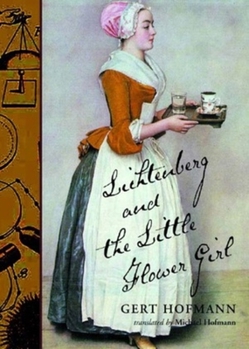Lichtenberg and the Little Flower Girl
Select Format
Select Condition 
Book Overview
Goethe, Nietzsche, Schopenhauer, Kierkegaard, Wittgenstein, Tolstoy, Einstein... all praised the writings of Georg Christoph Lichtenberg (1742-1799), a mathematician, physicist and astronomer by... This description may be from another edition of this product.
Format:Hardcover
Language:English
ISBN:0811215687
ISBN13:9780811215688
Release Date:May 2004
Publisher:New Directions Publishing Corporation
Length:245 Pages
Weight:0.20 lbs.
Dimensions:1.0" x 5.3" x 7.0"
Customer Reviews
2 ratings
Strange silent-filmic, vaudevillian comic angles on the most ordinary daily things
Published by Thriftbooks.com User , 15 years ago
Michael Hofmann's poem "Epithanaton," from Approximately Nowhere (Faber, 1999), which contains a dozen poems about the death of Gert Hofmann, begins: Last words? Probably not, or none that I knew of, by the sea with your grandsons in another country when it happened. A completed manuscript on your desk . . . That completed manuscript on the desk--perhaps the closest thing to Gert Hofmann's last words--was Kleine Stechardin, translated by Michael Hofmann as Lichtenberg and the Little Flower Girl. In his "Afterword," Michael Hofmann reminds us that his father was a "late starter" at fiction, having for many years traveled, professing German literature and writing plays for the stage and for radio. After publishing his first novel in 1979, he wrote nearly a novel a year until his death in 1993. This one, like the previous two--The Film Explainer and Luck--is full of quick, witty dialogue and strange silent-filmic, vaudevillian comic angles on the most ordinary daily things. On its surface, Lichtenberg and the Little Flower Girl is a fictionalized story of a few years in the life of Georg Christoph Lichtenberg (1742-1799), a hunchbacked professor of physics (and math and astronomy and electricity and nearly anything else the Enlightened 18th century called "scientific") in Göttingen, Germany, and the story of his "highly irregular" affair with teenaged flower girl Maria Stechard (1764-1782)--die kleine Strechardin, the little Stechardess. The plot follows Lichtenberg's path from his lonely, desperate, sniping bachelor days--reviling his students, his colleagues, and the world of learning--to his brief happiness as a Humbert Humbertish pedophile who eventually charms his way into the thirteen year old girl's intimacies. She moves from being his house girl, to lover, to student and companion. He even teaches her to read, though she often stumbles over "a word she didn't know, like `moralize' or `abomination'." But none of this scandalous behavior really seems the point of this novel. Instead, this is a book that explores the full scope of eros: the love of learning and the joy of discovering not only immortal scientific truths but also words, stories, the mysteries of another human being, and how love (and lust) transforms one's reality. Drawing on Lichtenberg's writings (his letters and especially the aphorisms of his Waste Books, so admired by Nietzsche, among others) and filling in the gaps with his own concoctions, Gert Hofmann's Lichtenberg is an outrageous, tiny, impatient, paranoid, vain, horny, hypochondriac who prides himself on his silver buttons, dandyish outfits, and yellow wigs as he parades around gossipy Göttingen, hoping for a windblown peek up a woman's skirt, and embarrassedly putting up with all sorts of people staring at--and even touching--his hump. Some days he can't be bothered to speak with his hundred students (though sometimes there are only ninety-nine) or fellow scientists, and sometimes he can't wait to dazzl
For those who don't measure historical novels by the pound.
Published by Thriftbooks.com User , 19 years ago
Written in 1993 but just recently translated into English by the author's son, this final novel by Gert Hofmann reflects his background as a playwright and radio scriptwriter. Dialogue, along with the main character's inner thoughts, constitutes virtually the entire novel. Stripped-to-the-bone and lacking the descriptive paragraphs one would expect in an historical novel set in late eighteenth century Gottingen, the narrative is told in a simple style and in short sentences reminiscent of fables and children's stories. The humor and the observations about life, however, are decidedly adult, and the insights into the strange life of Georg Lichtenberg, a real mathematician-astronomer-physicist, give a broad picture of scientific investigations and social life in Germany during the period.A hunchback, who can not leave his house without being pestered by people who want to touch his hump "for good luck," Lichtenberg is something of a dandy, affecting silver buttons and multicolored wigs. Always fascinated by new observations, especially his own, he carries a "waste book," in which he records his passing thoughts and dozens of aphorisms: "If a man has webbed fingers, he is unlikely to make a great flautist." On one of his walks, he buys flowers from a beautiful thirteen-year-old child, Maria Dorothea Stechard, who eventually moves in with him, becoming his student, then his housekeeper, and finally his mistress. Keeping "the little Stechardess" hidden from his friends for many years, he shares his scientific experiments on electricity, hot air ballooning, and phrenology with her, feeling "doubly near" her when he can share both his love and his science.Reminiscent in some ways of Penelope Fitzgerald's The Blue Flower, this slim novel is far less descriptive, a story reduced to its absolute essentials with not an extra word. Understated in the extreme, it is a peculiar story of seduction, often witty and often discomforting, giving a unique view of late eighteenth century academic, intellectual, and social life. Mary Whipple





